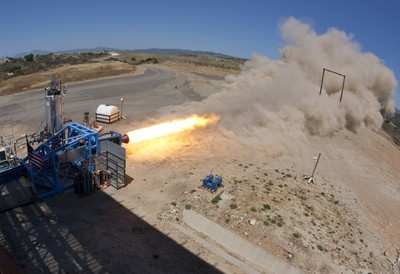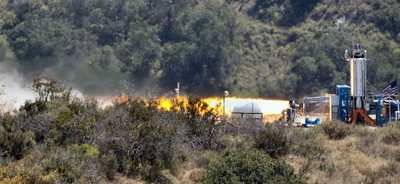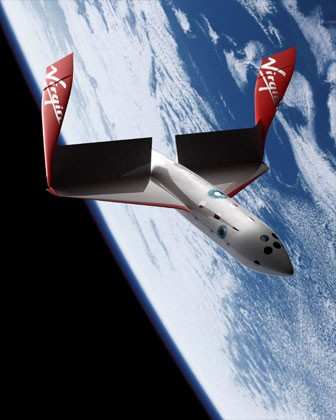Fri, May 29, 2009
Flight Tests Scheduled For Late '09
 In the desert of southern
California, Virgin Galactic’s key supplier, Scaled
Composites, and its subcontractor SNC (Sierra Nevada Corporation)
have successfully completed the first tests of the innovative
rocket motor that will propel space tourists, scientists and
payloads into space. The hybrid Nitrous Oxide system being used is
the largest of its kind in the world and it will send
Virgin’s customers up into sub-orbital space at speeds over
2500 mph, to heights over 65 miles above the Earth’s surface,
before the spaceship descends back down through the atmosphere
using its pioneering feathered re-entry system.
In the desert of southern
California, Virgin Galactic’s key supplier, Scaled
Composites, and its subcontractor SNC (Sierra Nevada Corporation)
have successfully completed the first tests of the innovative
rocket motor that will propel space tourists, scientists and
payloads into space. The hybrid Nitrous Oxide system being used is
the largest of its kind in the world and it will send
Virgin’s customers up into sub-orbital space at speeds over
2500 mph, to heights over 65 miles above the Earth’s surface,
before the spaceship descends back down through the atmosphere
using its pioneering feathered re-entry system.
Sir Richard Branson, founder of Virgin Galactic said: “As
Virgin Galactic gets ever closer to the start of commercial
operations, we are reaching and passing many important and historic
milestones. The Virgin MotherShip (VMS) Eve, the first of our
amazing, all carbon composite, high altitude WhiteKnightTwo launch
vehicles, is flying superbly. SpaceShipTwo, which will air launch
from Eve, is largely constructed and awaiting the start of its own
test flight program later this year.”
The rocket motor burns for a very short period of time because
the spaceship is launched from VMS Eve in the upper atmosphere,
rather than from ground level. This means much less fuel is
required, and the fuel burn is more environmentally benign than the
solid rockets used in most ground based systems.

While the rocket motor is extremely powerful, it is also completely
controllable. This system can - if necessary - be shut down at any
time, allowing the spaceship to glide back down to land at a
conventional runway. This is a significant feature in the overall
safety of the Virgin system for human space flight.

Sir Richard continues: “Less fuel and clean fuel all add
up to a space launch system which will be completely unprecedented
in its low environmental impact compared with current space flight.
The spaceship’s carbon footprint for each of its passengers
and crew will be about a quarter of that for a return trip from
London to New York."

The rocket motor will continue a series of exhaustive tests, and
the spaceship itself will start flight testing later this year.
More News
Aero Linx: Space Medicine Association (SMA) The Space Medicine Association of the Aerospace Medical Association is organized exclusively for charitable, educational, and scientific>[...]
Jamming Denotes emissions that do not mimic Global Navigation Satellite System (GNSS) signals (e.g., GPS and WAAS), but rather interfere with the civil receiver's ability to acquir>[...]
Aero Linx: Warbirds of America The EAA Warbirds of America, a division of the Experimental Aircraft Association in Oshkosh, Wisconsin, is a family of owners, pilots and enthusiasts>[...]
"From New York to Paris, this life-size replica of the Webb Telescope inspired communities around the world and, in doing so, invited friends and families to explore the cosmos tog>[...]
Hold-In-Lieu Of Procedure Turn A hold-in-lieu of procedure turn shall be established over a final or intermediate fix when an approach can be made from a properly aligned holding p>[...]
 ANN's Daily Aero-Linx (04.17.24)
ANN's Daily Aero-Linx (04.17.24) ANN's Daily Aero-Term (04.17.24): Jamming
ANN's Daily Aero-Term (04.17.24): Jamming ANN's Daily Aero-Linx (04.18.24)
ANN's Daily Aero-Linx (04.18.24) Aero-News: Quote of the Day (04.18.24)
Aero-News: Quote of the Day (04.18.24) ANN's Daily Aero-Term (04.18.24): Hold-In-Lieu Of Procedure Turn
ANN's Daily Aero-Term (04.18.24): Hold-In-Lieu Of Procedure Turn






